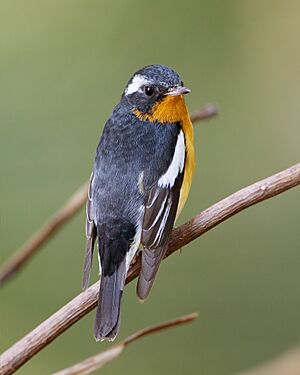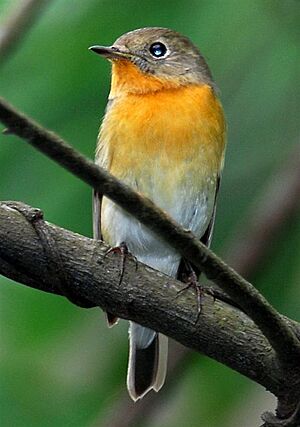Mugimaki flycatcher facts for kids
Quick facts for kids Mugimaki flycatcher |
|
|---|---|
 |
|
| male | |
 |
|
| First winter male | |
| Conservation status | |
| Scientific classification | |
| Genus: |
Ficedula
|
| Species: |
mugimaki
|
The mugimaki flycatcher (Ficedula mugimaki) is a small, colorful bird. It belongs to a group of birds called Old World flycatchers. These birds are known for catching insects in the air. The name "mugimaki" comes from Japanese and means "wheat-sower." This bird is also sometimes called the robin flycatcher because of its bright colors.
Contents
What Does the Mugimaki Flycatcher Look Like?
The mugimaki flycatcher is a small bird, about 13 to 13.5 centimetres long. That's about the length of a pen! It makes a rattling sound and often wiggles its wings and tail.
Male and Female Differences
The adult male mugimaki flycatcher is very striking. It has dark, almost black, feathers on its back and head. You'll see a short white stripe just behind its eye. This stripe is called a supercilium. Males also have a white patch on their wings and white feathers at the base of their tail. Their chest and throat are a bright orange-red, while their belly is white.
Female mugimaki flycatchers look a bit different. They are grey-brown on their upper parts. Their chest and throat are a pale orange-brown. Females usually don't have white in their tail. Instead of a big white wing-patch, they have one or two faint pale bars on their wings. Their eye stripe (supercilium) is either very light or not there at all.
Young male flycatchers look a bit like the females. However, their chest is a brighter orange. They also have some white in their tail and a clearer eye stripe.
Where Do Mugimaki Flycatchers Live?
Mugimaki flycatchers spend their summers breeding in eastern Siberia and north-east China. When autumn arrives, these birds start their long journey south. They fly through eastern China, Korea, and Japan.
Winter Homes and Travel
These amazing birds spend their winters in warmer places. They travel all the way to Southeast Asia, including western Indonesia and the Philippines. Sometimes, a bird might get lost during its long migration. There was one time a mugimaki flycatcher was seen far away in Alaska!
Favorite Places to Live
Mugimaki flycatchers love to live in forests and woodlands. They especially like areas that are higher up, like on hills or mountains. When they are migrating, you might also spot them in parks and gardens. They usually fly alone or in small groups. They mostly eat flying insects, catching them right out of the air from the tree branches.


